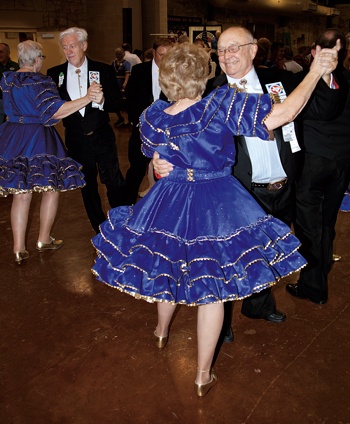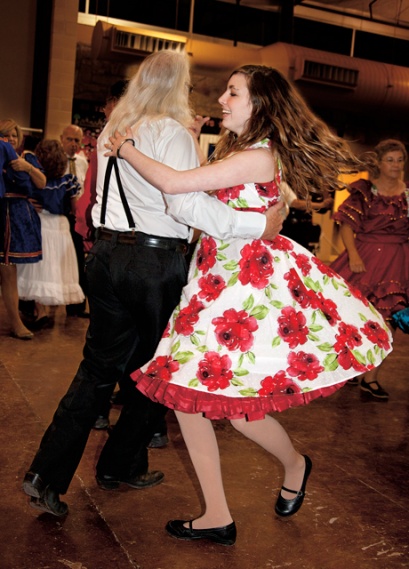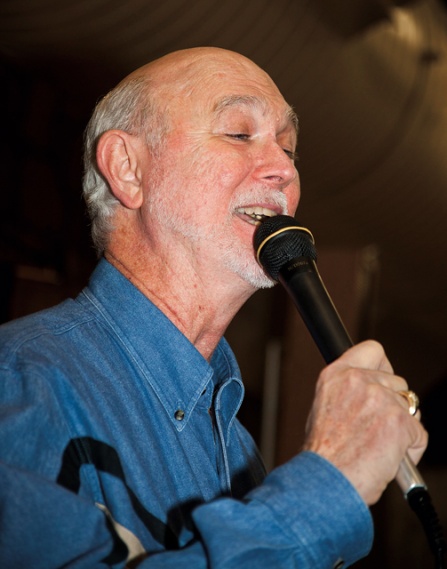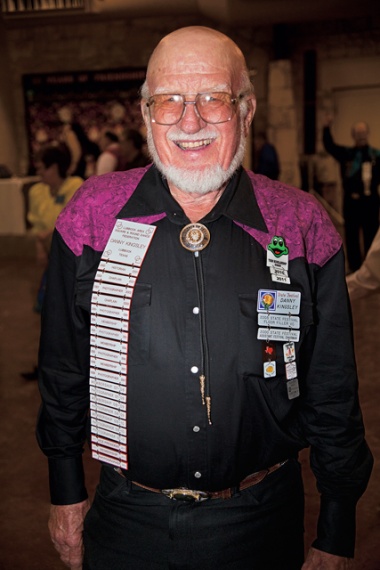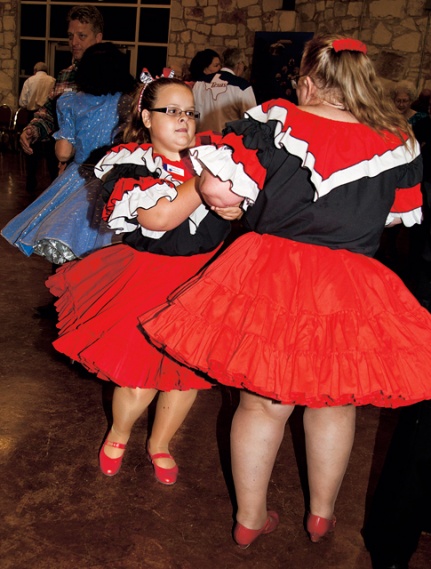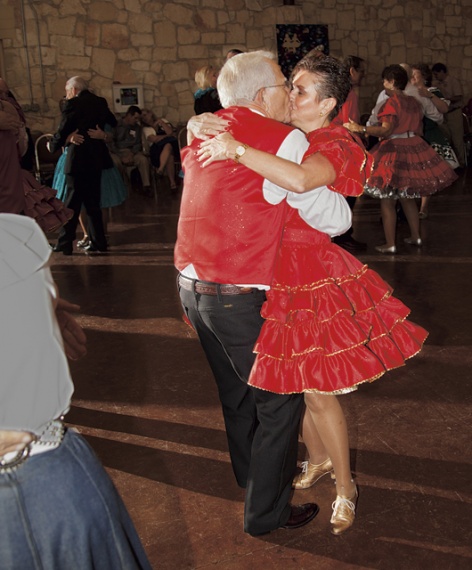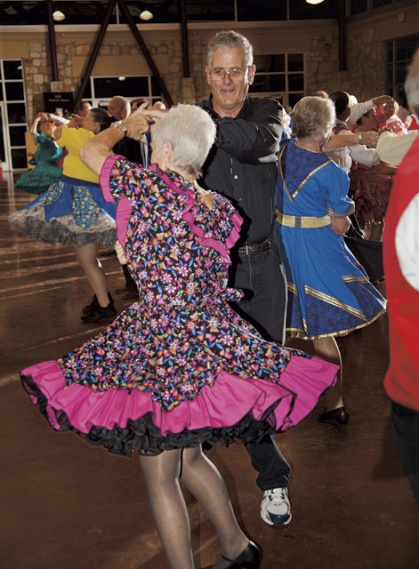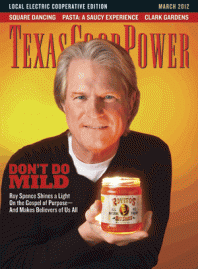No fancy signs or neon lights mark the cinder-block building at the end of Locust Street in San Angelo. Only a lone twirling couple, silhouetted in dark green paint on an outside wall, hints that we’ve found the right place—the Promenade Squares clubhouse, where members square dance every Thursday night.
Inside the wood-paneled hall, we find a dozen or so people milling around two long tables at one end of the dance floor. A few who’ve already claimed folding chairs are chatting. One man is seated by the refreshment table that’s piled with snacks and salads.
Right away, a gray-haired lady, outfitted in a black ruffled skirt and blouse trimmed with gold lamé, greets us warmly. After brief introductions, Patricia Cain, 82, who’s square danced since 1989, unabashedly shares her enthusiasm for the fast-moving pastime. “If you don’t dance, you’ll dry up!” she insists good-naturedly. “We have lots of fun. We’ve become family, too, because if anyone’s missing, we know it.” She grins, then warns, “If you don’t laugh while you’re here, you’re in trouble!”
At the other end of the hall, caller John Geen, 78, holding a microphone on a small stage, readies for the evening. His wife, Nora, 78, staffs the registration table. For the past half of their 60-year marriage, they’ve square danced. Onstage, John turns on a vintage record player and announces the evening’s first tip (see glossary at right). In no time, men in Western shirts and ladies in swishy skirts and petticoats stroll to the floor and form two large squares. The music starts. Smiling and laughing, cheering and clapping at times, everyone twirls and bobs in time to John’s lilting voice.
“We shall gather by the river … four hands together, veer to the left, my friend … Go allemande, now veer to the right, Ferris wheel you go … Yes, we shall gather at the river …”
As the two-hour dance unfolds, I sneak peeks at my husband, James. He came along only so I wouldn’t travel alone. “Square dancing isn’t cool,” he’d scoffed several times, wrinkling his nose. I wonder what he thinks now.
Dance Across Texas
Today, roughly 6,000 Texans square dance regularly, according to The Texas State Federation of Square and Round Dancers, which is composed of 131 square dance clubs with nearly 4,000 total members. Geographically, the organization splits the state into 15 districts (the Texas State Camping Squares is statewide). Two more districts stand alone as regional associations. The North Texas Square and Round Dance Association, which includes the Dallas-Fort Worth Metroplex, has 34 clubs and more than 1,600 square dancers. The Westerners Square and Round Dance Association, which encompasses the Abilene area, includes five clubs with more than 80 square dancers.
Generally, dancers belong to a local club and pay annual dues. At weekly dances, they may give donations (in lieu of a cover charge), which pay for building expenses and caller fees. (Note: Some clubs also host round dancing, another kind of folk dance in which a cuer calls out steps while couples dance counter-clockwise in one circle.) Clubs host dances on regular days of the month (such as every Thursday or first and third Fridays) at churches, recreation centers, senior centers, schools and even restaurants. Some own their own dance halls. Callers play a variety of music genres, including country and western, hymns, folk songs and even rock ’n’ roll.
Many square dancers wear traditional dance attire: guys in Western-style shirts with long sleeves (so gals don’t have to hang onto hairy, sweaty arms) and ladies in ruffled skirts with flouncy petticoats and frilly pettipants. Some square dancers wear whatever they want. Weather permitting, they may even show up in shorts and flip-flops. Also, nearly every club has its own pin-on badge, which members wear as a name tag. Like a charm bracelet, members attach their own commemorative dangles to the badge.
Learning Basics in San Marcos
At the Dunbar Recreation Center in San Marcos, I’ve barely stepped out of my vehicle when Ted Zahorski, 66, flags me down. He and his wife, Nancy, 58, are regulars at the Thursday night dances hosted by the Wheel-N-Deals club. Grinning ear to ear, he ushers me into the main hall, where other members are gathering. Most are dressed in casual attire, like jeans and skirts. A few men are in shorts and sandals. While I sign the registry, several folks amble by. Some give me quick hugs. “Hey, welcome!” they exclaim.
“This is better than church!” I sputter, surprised at the extra-friendly atmosphere.
But no time to visit. The music’s starting, and tonight, lessons run for the first 1 1/2 hours. “C’mon,” urges Milton Vaverek, 77, who’s square danced since World War II. “You’re here to dance, right?” Sure, I nod as he grabs my hand and leads me to the floor. Everyone in my square makes introductions. Then caller Chet Miles, up front with a microphone, clicks a digital music track on his computer and begins calling: “Circle to the right, circle to the left, promenade home! Dancers, swing your partner, join hands, circle left, now allemande …”
Oops, I mess up an allemande, a dance movement, by grabbing Milton’s hand instead of his forearm. “You’re doing great,” he grins. Gee, no wonder beginner square dance lessons can run as long as 10 weeks. Basic “mainstream” calls tally up to 68. Add another 30 or so calls, and dancers reach the “plus” level. Two “advanced” levels add 32 more calls. “Challenge” levels add even more calls! Undoubtedly, square dancing provides both cardio and cognitive workouts.
The lessons end. Now mainstream and plus dancers will enjoy the last hour on the floor. “My wife and I started dancing a year ago,” says Ed Wedig, 65, who’s taking a breather. “Now we know hundreds of people, and I’ve lost 25 pounds! We belong to the FunDancers in Schertz, but we like to visit other clubs.”
Ernest Williams, 74, is also visiting. He belongs to the Cliff Dwellers in Duncanville and has square danced for 15 years. “For the most part, it’s real forgiving,” he tells me. “It’s OK if you make mistakes. Nobody cares.”
That’s exactly what Ted Zahorski says. “Square dancing is more about getting into the right position and knowing your right hand from your left,” he explains. “It doesn’t matter if I take one step or five.”
President’s Dance
Three times a year, state square dancing federation officers and members gather in various cities to discuss business and plan the annual state festival, which last year drew 900 dancers. (This year, Wichita Falls will host the federation’s 50th annual festival, set for June 7-10.) They also dance! At the President’s Meeting and Dance, held last October in Georgetown, I met square dancers of all ages. At these galas, everyone wears fancy square dancing attire.
Outfitted in a floral dress with a ruffled skirt and petticoat, 14-year-old Meagan Rutledge of Amarillo shyly tells me that in a few years she’ll apply for one of the federation’s annual Texas Teen Scholarships. In 2010, the organization awarded $1,500 scholarships to 10 high school seniors who’ve square or round danced at least two years. They must also belong to a club affiliated with the federation.
“I’ve gone to the clubs with my parents ever since I can remember,” shares Meagan, who belongs to the Texas Twisters. “I’ve met people from all over the globe. I’ve found it to be really fun. I want to get my friends interested!”
I’d like to meet another young square dancer, but at the moment Austin dancer Lise Waring can’t find her 10-year-old daughter Martha. “There’s a whole lot of chaperones here so I don’t worry about her,” Lise says. “Our whole family dances. Martha took lessons between first and second grade. Oh, here she is!”
Sounding very grown up, Martha patiently answers questions. “It’s hard to say what I like most about square dancing because I’ve been at it so long,” she says. “I went with Mother to Monday dances, and I find it quite interesting. Since then, I’ve learned to do mainstream and plus.”
Like Martha, K.O. Jeanes, 51, a caller and square dancer from Conroe, inherited the pastime from his parents. “Most callers call for the love of it,” he says. “It’s tough to make a living from calling because of the costs involved, such as computers, music and other equipment. Most callers love to square dance, too.
“Square dancing is a great family activity because there’s no smoking and no drinking,” he continues. “It’s just good old-fashioned fun with good people. Unfortunately, parents nowadays are too busy to square dance. But when the nest is empty, they’ll show up again.
“We need George Strait to square dance, then we’d be fine,” he quips, referencing the enormously popular country and western singer.
Like on the frontier, square dancers still find true love on the dance floor. Nora Creed, 60, publicity director for the state square dancing federation, met fiancé Robert MacLaren, 72, at Lone Star Solos, a Dallas club. The two plan to marry this spring in Mesquite.
Mike and Dana Goggin, who belong to Shirts ’n’ Skirts in Round Rock, met as teenagers at a Houston club. “My parents square danced,” recalls Mike, 57. “When I was 16, I was told to take one lesson, and after that, it was my choice. But after that one lesson, I was hooked! Soon after that, I met my wife. We’ve been married 40 years.”
After the dance ends, federation Secretary Theresa Keane briefly voices a concern echoed by many square dancers: Their numbers are shrinking. “If we can get people in here, they’ll find out it’s fun,” she says. “As an association, we’re trying to figure out how to do that.”
San Angelo Squares
Back at the Promenade Squares hall, mainstream and plus dancers twirl across the floor. From the sidelines, James and I watch and visit. In between tips, we try some line dancing. Later, James hits it off with Donnie Dunagan, 77, the voice of young Bambi in the 1942 Disney classic. His wife, Dana, 59, sewed her colorful cotton outfit sporting cupcake designs with matching petticoats. “I rehab vintage attire and turn it into new,” she says. “Very rarely do I part with money!”
Seated against the wall, Linda Wirth, 71, can’t dance because of a leg injury sustained last June. But that hasn’t stopped her from showing up every Thursday since. “These people are more than my friends. They’re my family,” she says.
Seated by the refreshments, Charlie Grohman, 78, has danced more than 25 years. His wife died in 2000, and since 2004, he’s partnered with JoNell Burden, 71. “Charlie was my angel when I took lessons,” she says. “Square dancing is such fun! Plus, we meet such lovely people. That’s why they call square dancing ‘friendship set to music.’ ”
Alas, the evening’s last tip ends, and everyone hugs. It’s time to go home. “What?” James exclaims, both surprised and disappointed. “The dance is over? Already? We just got here!” Hey, no need to ask my husband if he likes square dancing now. The big smile on his face says it all.
——————–
Sheryl Smith-Rodgers, frequent contributor
